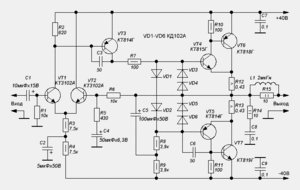Analogi Tranzistora K2645
воскресенье 14 апреля admin 43
Ariazone 5001 FAHD II OPERATOR MANUAL. Only Ariazone genuine parts are to be used for maintenance and repairs. Urdu fonts for inpage 2009 download pdf. - Maintenance of the unit must only be performed by an authorized technician. - Only non aggressive substances to be used for cleaning of the unit.
In 1988, the gene responsible for the autosomal recessive disease ataxia- telangiectasia (A-T) was localized to 11q22.3-23.1. It was eventually cloned in 1995. Many independent laboratories have since demonstrated that in replicating cells, ataxia telangiectasia mutated (ATM) is predominantly a nuclear protein that is involved in the early recognition and response to double-stranded DNA breaks.
ATM is a high-molecular-weight PI3K-family kinase. ATM also plays many important cytoplasmic roles where it phosphorylates hundreds of protein substrates that activate and coordinate cell-signaling pathways involved in cell-cycle checkpoints, nuclear localization, gene transcription and expression, the response to oxidative stress, apoptosis, nonsense-mediated decay, and others. Appreciating these roles helps to provide new insights into the diverse clinical phenotypes exhibited by A-T patients—children and adults alike—which include neurodegeneration, high cancer risk, adverse reactions to radiation and chemotherapy, pulmonary failure, immunodeficiency, glucose transporter aberrations, insulin-resistant diabetogenic responses, and distinct chromosomal and chromatin changes.
An exciting recent development is the ATM-dependent pathology encountered in mitochondria, leading to inefficient respiration and energy metabolism and the excessive generation of free radicals that themselves create life-threatening DNA lesions that must be repaired within minutes to minimize individual cell losses. Introduction Ataxia-telangiectasia (A-T) is an autosomal recessive disorder characterized by a broad spectrum of disease phenotypes that can be viewed from many perspectives, much like the Indian parable of the blind men probing different parts of an elephant while not seeing the entirety of the animal, because each relies on only 1 methodology—his touch. The A-T phenotype is similarly complex and includes progressive neuronal degeneration, ocular telangiectasias, variable immunodeficiency, and cancer susceptibility, - whereas the overall functions of the ataxia telangiectasia mutated (ATM) protein suggest a much broader pathology. Indeed, the extended phenotype can include growth retardation, premature aging, insulin resistance, manifestations of mitochondrial dysfunction, inadequate responses to oxidative stress, and adverse reactions to the DNA-damaging agents commonly used to treat cancer. Cells derived from A-T patients exhibit cytoskeletal abnormalities, requirements for serum growth factors and clastogenic factors,,, chromosomal instabilities, - chromatin changes, hypersensitivity to ionizing radiation,, and aberrant checkpoint controls. The gene responsible for A-T was first localized to chromosome 11q22.3-23.1 by Gatti et al using mathematical analysis of cosegregation (linkage) data. During the next 7 years, the region was “fine mapped” by an international consortium, - and then identified as the ATM gene by Savitsky et al. Blank zhd nakladnoj gu 29 o.
